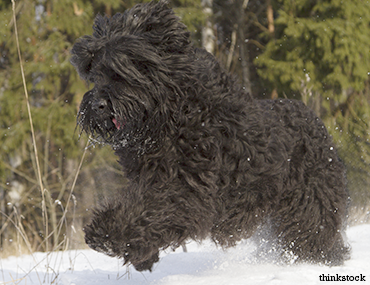Background
Developed in Moscow, the Black Russian Terrier made his debut after World War II. Bred by crossing a Giant Schnauzer with breeds such as the Airedale, the Rottweiler, and the Moscow Retriever -- he was primarily used for military and police work.
The Black Russian Terrier was recognized by the American Kennel Club in 2004.
Sizing up
- Weight: 80 to 145 lbs.
- Height: 26 to 30 inches
- Coat: Double, coarse, wiry topcoat with a softer undercoat which can be as long as 6 inches
- Color: Black with occasional gray hairs
- Life expectancy: 10 to 11 years
What’s the Black Russian Terrier like?
The Black Russian Terrier is an active and loving dog. He would enjoy a nice long walk or a hike. If he’s off his leash make sure he’s in a secured area since he has a tendency to dart after small critters. He loves his family and can get along with young children if raised with them.
The Black Russian Terrier is very smart and protective. His instincts make him one of the best guard dogs out there. He can be reserved with strangers at first but because of his high intelligence level he’s able to distinguish between dangerous situations that require action on his part and those that don’t. He doesn’t warmly welcome strangers onto his property.
The Black Russian Terrier, like most dogs, should be socialized and trained right away. Keep training sessions short because he doesn’t like to be taught things he already knows (he’s too smart for that). Always use positive reinforcement when he’s done something correctly!
Grooming is a simple task because the Black Russian Terrier is a low-shedding dog. You should brush him at least once a week, or as needed, to prevent tangles and mats. Make sure to remove any hairs in his ears and trim the hairs under his paws.
Health
The Black Russian Terrier is generally healthy, but you should be aware of the following concerns:
Urinary Tract Stones
- A condition that occurs when stones or crystals are present in an animal’s urinary tract; usually the stones are found in the kidneys and the tubes that connect the kidneys to the bladder
Hyperuricosuria
- A condition that produces high levels of uric acid in the urine and can lead to bladder stones and kidney stones
- One of the most common diseases seen in dogs, with larger breeds being the most affected. It’s ultimately a malfunction of the hip joints, and can deteriorate the joints over time, resulting in a loss of the function in those joints
- A condition that basically means the development of arthritis in the elbow joint
Progressive Retinal Atrophy
- An eye condition that worsens over time and could lead to a loss of vision
Takeaway points
- The Black Russian Terrier would make an excellent watchdog
- The Black Russian Terrier hardly sheds – routine grooming is easy
- The Black Russian Terrier is more suitable to a home with older children
- The Black Russian Terrier has a strong prey drive. It’s recommended that you have a fenced in yard
If you have any questions or concerns, you should always visit or call your veterinarian -- they are your best resource to ensure the health and well-being of your pets.
